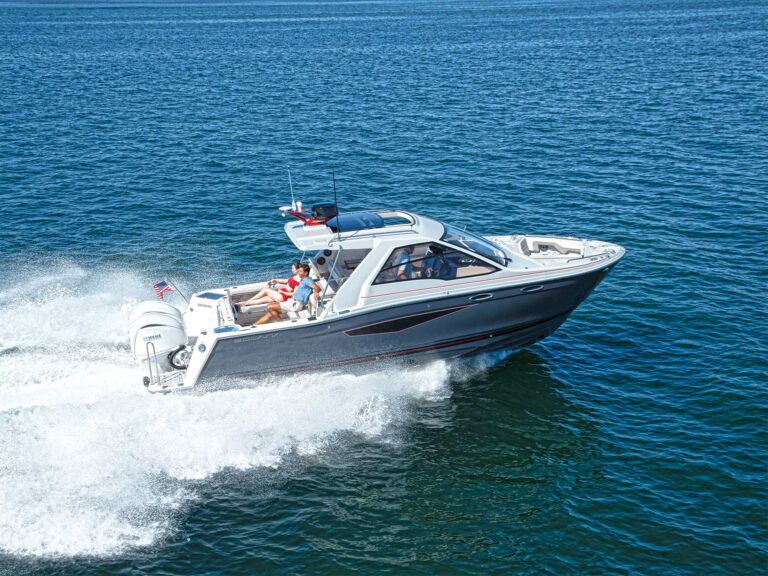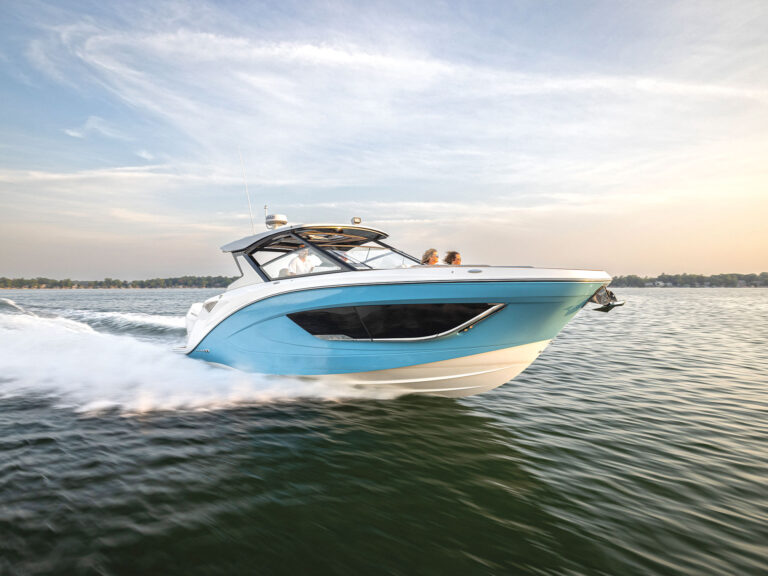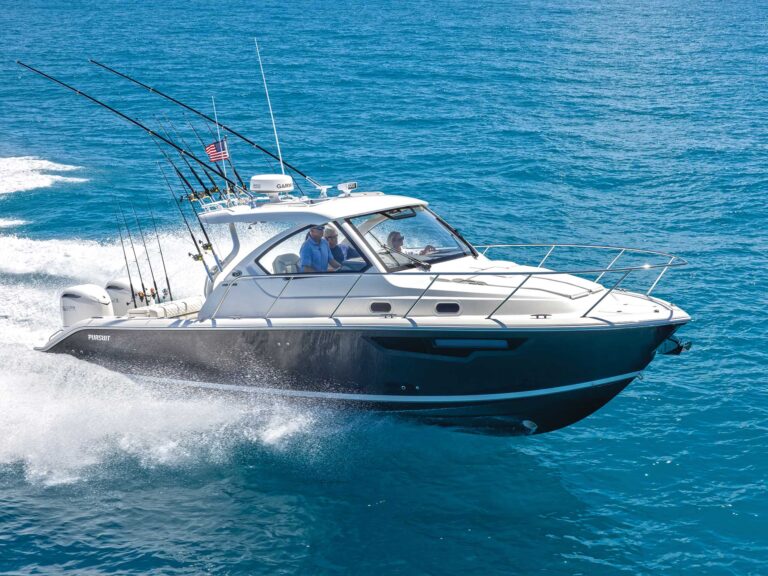It’s the end of an idyllic day. Your engine is burbling through the no-wake zone, water’s chuckling against the hull. The sunset is molten gold. It’s perfection, and yet…you can’t place it, but something is missing. A something to make this moment last forever. You know, like a scene from a movie. I’ll tell you what’s missing-a soundtrack. You’ve known it since seeing Lawrence of Arabia-life would be nine ways better if it had background music. And not just any music-your music. Scored by the Great Mancini in the Sky, it would always be there, marinating your maritime life in surround sound. Some pounding Aerosmith when you’re flying high and hard offshore, or a little Miles Davis for times like now as the sun slides into the sea. The problem is, the stock marine stereo systems on most boats are more suitable to providing background to a Warner Brothers cartoon, not a life of high romance and drama. I bet Yugos came better equipped for sound than your boat. To find out how to repower what you have or learn how to get the right marine stereo system for your new boat, we tracked down John “The Ear” Marrero. A systems designer at Custom Sight and Sound (954/527-5554), near Palm Beach, Florida, he’s created musical experiences on everything from 15- to 150-footers. He also knows how to make your boat worth listening to without being accompanied by the sound of your bank account being flushed down the drain. Let’s hear what he has to say.
Worth Listening To
“I hear everything,” says Marrero, and he’s only half kidding. He comes by his expertise genetically: a family in music, and a youth misspent doing what he calls “sound reinforcement” for the B-52s.
Today I’m following him through one of his typical installations, aboard a 158′ Italian megayacht. It’s getting a complete audio refit, and the interior has been almost completely gutted. All the paneling is down and Marrero’s crew is running wires-everywhere. Marrero’s average marine stereo system costs upwards of $80,000. This one will be billed out at more than $200,000.
Of course, you can spend $50,000 for a pair of speakers and get fantastic sound, but you don’t need to. If you know how to listen, you can hear when fine sound is coming from modest equipment. “Anyone,” Marrero says, “can distinguish good sound from better sound.” This is the key ability you’ll need when shopping.
To make his point, Marrero puts me in front of a $2,500 pair of Revel speakers he considers to be good-and oh, my! They deliver such a deep sound that it feels like you could walk into it and stroll around. The two high-end speakers Marrero favors are the California-built Revels and B&W speakers from England.
“Good audio produces more detail and clarity,” Marrero explains, “for a full presentation.” These aren’t the empty modifiers used by wine critics. You don’t have to be Niles Crane to grasp the meaning of clarity and detail. Marrero means them quite literally. Better detail means you hear more bits of sound information. The cymbal is more like a cymbal, because you hear the fine tingle of its vibration. And you hear the saxophone’s reed vibrating on the mouthpiece, the slight ring of the horn’s brass body-and if you have ears like Marrero, you can identify it as a Selmer Model Mark VI.
Clarity refers to sharp definition between various sounds. In great audio, as in a live performance, you are aware of a physical distance between the instruments as opposed to the “wall” of sound we hear with mediocre audio.
If all that sounds intimidating, relax. You’ll hear the difference just as easily as you can smell burnt toast. When comparing, it’s that obvious. What is better, according to Marrero, is that audio technology is constantly improving. Indeed, it’s probably better right now than it was when you began reading this article, which is great news for us nonbillionaires. Sure, $50,000 speakers are untouchable for monetary mortals. Yet we all profit from this high-end excess. As things improve at the top, the entire range below reaches up to meet it.
“Comparing today’s audio quality, dollar for dollar, with what was available 10 years ago,” Marrero says, “makes it look like we’re living in an audio bargain basement.” To prove this, consult our shopping list (“Real World, Real Ears”) to match your marine stereo system budget.
Real World, Real Ears
The $200 Solution Custom Sight and Sound’s John “The Ear” Marrero recommends the handy, portable Sony Sport Series CFD-980. It’s a rugged, splash-resistant CD/cassette/ radio with 10-second shock protection for its CD player, which provides a signal for 10 seconds despite interruptions due to rough-water impacts. Bright yellow and tough, the CFD-980’s sound is good enough to satisfy The Ear, but be careful-this unit doesn’t swim. It lists for $199 but can be found for $149 or less.
The $500 to $700 Solution Marrero recommends the Poly-Planar AM/FM/cassette stereo ($320), ideal for a center console or sportboat, combined with either Poly-Planar Platinum Series speakers ($200 to $290 a pair) or MB Quart speakers ($300 to $400 a pair). Marrero, however, cautions against choosing Poly-Planar Premium Series speakers ($100 a pair): “They’re for the guy who just doesn’t care.” The Poly-Planar head unit is marinized and has a weather-protected tape port and a floating remote. For integral CD, add $150 to the cost of the head unit. “You can find cheaper Taiwanese systems,” Marrero says, “but they’re poorly marinized and will most likely require replacement much sooner.”
The $1,500 Solution A slightly bigger boat, or slightly more demanding ears, will be satisfied by selecting the $700 solution and adding the following. First, put in an automotive audio amplifier such as a Sony XM 475GSX ($400). “Most marine systems are underpowered,” says Marrero. However, you must ensure that your boat’s electrical system has enough power to drive a bigger amplifier. The bare minimum is 40 amps, but 60 amps is more realistic. This means upgrading your alternator and batteries. Next, buy a second pair of speakers ($300 to $400) so you’ll have music in the cabin and on deck. It’s important to add individual speaker-volume controls for the two sets, so one set isn’t blasting the other out.
The $4,000 Solution There’s not much improvement to be made to the $1,500 solution. But you can start building a serious onboard marine stereo system and entertainment center. Add a Sharp flat-screen TV (about $1,100) and a Sony DVX-100 DVD player (about $1,200).
The $8,600 Solution Once your boat goes over 40′, you have room to do things right. Take our top end and add a 13″ Sharp LCD display for TV and DVD, plus a Furuno nav-display with a video card so your radar can do double duty as a DVD viewer. Include a six-disc CD changer such as a Sony CDX-T70MX ($250). Fit four exterior speakers and four interior surround-sound speakers, each of which needs its own volume control. Now add a unified controller from Crestron ($3,000 programmed) to allow all systems to be easily accessed without hunting through a shoebox full of remotes. Done.
Speaker Hints
-To avoid interference, keep speaker wires as far from the boat’s wiring and electronics as possible.
-Shielded oxygen-free wires with gold-plated connectors and silvered tips are best.
-Isolate the front of the speaker with an airtight enclosure.
-Cover speakers with acoustically transparent material.
-Speakers should be forward of the listener and at ear level. Do not put them in footwells or low to the deck.
Stick It in Your Ear
On deck, your marine stereo system’s biggest enemy is the wind. Look at our boat tests and you’ll see decibels (dB) levels-a measure of sound pressure, or loudness-in the high 80s and up into the 90s-while underway. To put this into perspective, a noisy restaurant or party where you have to talk loudly to be heard is 90 dB-A. Normal conversation registers at about 65 dB-A.
A killer audio system might be able to put out up to 140 decibels, but the quality of its sound, particularly the higher frequencies, will be lost to the breezes. To reduce wind-generated noise and get better audio, I had a pair of custom earplugs made with speakers imbedded in them from Now Hear This (305/477-2333, plugup@aol.com). The company advises you on how to make molds of each ear, which you then send to them. With these, and a check for $160, you get earplugs/earphones made from a nonabsorbent, hypoallergenic plastic that work with radios, and CD and tape players. Mine are red for the left and green for the right.
The plugs bring noise levels down by about 30 dB-A and allow you to listen to music at normal levels so there is no distortion. The sound quality is that of good “ear bud” speakers in a quiet room. External sounds are muted and I can hear what’s going on around me down to 50 dB-A, so safety is not an issue. In fact, now I can hear sounds that are normally covered by the wind. The only downside is that if you’re plugged into a dash outlet, you’re leashed in by the wire. With a portable unit, this is no problem.
On long trips in open boats, I have taken to wearing generic foam earplugs to cut down on hearing loss and exhaustion from wind noise. According to OSHA, 95 dB-A for four hours will damage your hearing. The foam plugs also reduce dB levels by about 30, but only when fitted properly, which is rare. Plus, after an hour, their fit starts to loosen, which reduces efficiency. The custom plugs give me peace and quiet, with the sounds I like.









